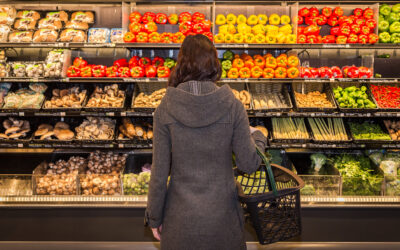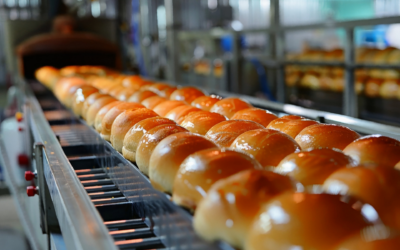Dr. Gary C. Smith, Colorado State University
More than 40 years ago, marketing gurus for food companies sought to identify “descriptors” (i.e., words that present a picture to a person who reads or hears them) they could put on a food label to differentiate their product from its competition. In the beginning, they chose words/terms that were self-explanatory (e.g., “Natural”, “Organic”); in 2008, they began to invent descriptors like “Green”, “Real”, and “Clean” (these three were drawn from the narrative in Michael Pollan’s book, “In Defense of Food”).1
The way this “Descriptor Strategy” works is: (a) the marketing department of a fruit company has an epiphany that it can sell more bananas if it adds the word “Wonderful” to its banana labels; (b) no one has ever done that, and no one knows what “Wonderful” implies, so the food company hires a consumer research firm to conduct a study or survey that shows that “X percent of all grocery shoppers are seeking ‘Wonderful’ food, Y percent of millennials favor ‘Wonderful’ over ‘Awful’ bananas, and Z percent will pay a premium for them”; (c) the research firm releases results of its study to the print media and internet; and (d) surprise, surprise…suddenly thereafter, “Wonderful Bananas” appear in the marketplace.
Can Consumer Polls Be Trusted?
The epitome of overreach in the interpretation of consumer-research findings can be achieved by the design of a well-crafted press release like, “A Nielsen Report® Found That 93% of US Households Presently Purchase ‘Clean Label’ Products, and 67% of US Consumers Want to Know Every Ingredient in the Food They Buy.”2 There’s nothing wrong or untruthful about the statement per se, but it is reminiscent of the old story that eating pickles caused cardiac-arrest mortality because, of all people who died of a heart attack, almost all of them had previously eaten a pickle.
In the Nielsen Report®, it doesn’t say the 93% intentionally purchase “clean label” products, it just says that 93% had some (probably bottled water) “clean label” products in their home. And the 67% who “want to know every ingredient in the food they buy” probably answered “Yes” to a binary like, “Do you want to know every ingredient in the food you buy?” as opposed to “No” (I don’t care what’s in my food). I’m surprised that only 67% care; but it doesn’t mean that two-thirds of shoppers carefully scrutinize the ingredient lists of every food product they do or don’t purchase. You can pose the questions in a survey in a manner that yields whatever outcome you want. I personally believe only the findings of those surveys that ask unassisted and open-ended questions.
“Green” Descriptor Loses its Appeal
“Green” originally meant “Earth-Friendly”; food characterized as “Green” was perceived as being produced in a sustainable, climate-protecting, and environmentally conscious manner.3 It had some traction but temporarily lost popularity as a descriptor because so many people associated the term with Greenpeace® (a radical environmental activist group). Europe’s largest pork producer (Danish Crown™) had to recall its “Green Label” claim (based on its Climate-Controlled® program) under pressure from retailers and Greenpeace®.4
But One Group Wants to Revive It
“Green” has recently been rescued; the United Kingdom Board of Trade believes use of the term “Green Trade” offers a major opportunity to bring together its trade plus climate agendas as it markets agricultural products.5 At present in the US, all that matters to some manufacturers and some retailers is to be able to say, “It fits the green label.”6
Does Climate Change Signal the End is Near?
The “Green Movement” and its climate-change narrative would have us believe that the end of the Earth is imminent; these activists have indoctrinated our children with false and foolish rhetoric.7 Bjorn Lomborg (Stanford University), a climate-change believer, says, “While climate change certainly exists, it is not the end of the world, and the policies currently being taken to address the problem are worse than ineffective – they are counterproductive.”8
Global warming is causing an unprecedented “greening” of the world; because of increases in CO2 over the past three decades, upward of half of the world’s vegetated area is getting “greener” whereas only 4% is “browning”.8 Climate change is costly, but so is climate-change policy. The Biden Administration’s green-energy policy (signing on to the Paris Agreement and COP-26 using executive orders) has increased the price of all foods; it seems highly unlikely that very many shoppers will pay the premium for “Green Label” food products.9
“Earth Friendly” Concept Splits in Two
When “Green” stalled, the “Earth-Friendly” concept was bifurcated: “Sustainable” became the descriptor for methods by which food is produced, while first “Real” and then “Clean” became the descriptor for the foods those systems produced.10
The move from “Green” to “Real” started when Joan Dye Gussow (author of “The Feeding Web”) said, “I have watched ‘Real Food’ disappear from supermarkets and restaurants, being replaced by food-like substitutes filled with artificial colors, flavors, fats, and sweeteners.” Michael Pollan believes we should stop eating anything: (a) our great-grandmother wouldn’t recognize as food; (b) is incapable of rotting; (c) contains ingredients that are unpronounceable, unfamiliar, more that five in number, or include high-fructose corn syrup; or (d) makes health claims. Having been codified as “Ordinary” by Gussow and Pollan, “Real” meant, “As Mother Nature made it” – leaving no room for the R&D folks to “improve” it by adding ingredients and no way for marketers to claim exclusivity.
“Real” Stalls as an Attractive Food Descriptor
“Real” never gained traction because the word translates as: (1) genuine, (2) not artificial, and (3) not imaginary; that word doesn’t work in an era when so many manufacturers merchandise imitations, substitutes, vegan/vegetarian versions, and plant-based meat/milk alternatives.10
Use of the word “Real” in combination with an animal-product name (e.g., “Real Beef”, “Real Pork”, “Real Chicken”) may soon appear on product labels; the National Cattlemen’s Beef Association and the National Chicken Council have filed comments to FSIS-USDA that would restrict use of certain words/descriptors on food labels and in marketing claims.11,12
Distaste for Ultra-Processed Foods Breeds “Clean-Eating” Movement
The “Clean-Eating” movement arose from dissatisfaction with the ubiquity of ultra-processed foods. For example, the ingredient list for Walmart™ Ring Donuts® contains 118 ingredients.13 Food marketers catered to a few “loud” consumers who wanted something “taken out of food” and created mass hysteria among others.14
Early on, Greenpeace® argued that “Clean” was being used as a synonym for “Green” and “Real”, when, in fact, it was a catchphrase and fake descriptor invented by food marketers to trick consumers.15 “Clean” has had its problems because, by connotation, it implies that food produced by any other production or processing method must be “Dirty”. Some food marketers decided to bolster existing, but waning-in-popularity, brands via resuscitation – by taking ingredients out of old staples.16
What is the Definition of “Clean Label”?
“Clean label” has no legal or regulatory definition. At its simplest, as early as 2015, some defined it as “free of artificial ingredients”,16 and as recently as 2022 some define it as “absence of unacceptable chemicals.”17
But, give activists and food marketers an inch and they’ll take it a mile. In 2016-2017, some insisted it must be non-GMO; organic; natural; free of pesticides, chemicals, or toxins; allergen-free; gluten-free; transparently packaged; vegan-friendly; minimally processed; raw; paleo; grass-fed; free-range; and pasture-grown.18,19,20 Others added in 2019-2021 included fresh; not highly processed; and free of antibiotics, hormones, preservatives, thickening agents, MSG, and high-fructose corn syrup.21,22,23,24
What Do Consumers Look for on a Product Label?
Of those consumers who claim to read ingredient lists, they say they are looking for: (a) familiar, simple ingredients (the fewer the better) that are easy to recognize and pronounce, and (b) no artificial colors or flavors, no artificial sweeteners, and no GMOs.2
Ever since consumers began clamoring for ingredient lists they can understand, food manufacturers have sought to provide “a product that consumers can trust and feel good about.”25 Experts in food labeling say the key to a “clean label” is removing anything in the ingredient list that has the following:
- The letter “x”
- Hyphens
- Numbers
- More than three syllables in its name26
Many Consumers Care More About What is Not in Food Than What Is
More than half of all consumers say the exclusion of undesirable ingredients is more important than the inclusion of beneficial ones.27 Before deciding to buy a product, more and more consumers pay particular attention to the number of ingredients listed and whether the list includes familiar names; of the two components – length and familiarity – the latter is the most important to consumers.28
How Do Manufacturers Create “Clean Labels”?
Some food manufacturers create “clean labels” by removing ingredients with unfamiliar or scientific names, and replacing them with ingredients that have common or recognizable names.29
For example, a label that contained lactate, diacetate, nitrite, erythorbate, and phenolic could be “cleansed” by taking those ingredients out of the product and replacing them with (in order) cultured milk, vinegar, celery juice, cherry powder, and fruit extract.29
One company converted its traditional product into a “clean-labeled hot dog” with claims of “No artificial preservatives” and “No added nitrites/nitrates” by using vinegar (which is actually acetic acid) and celery juice (which contains nitrates) in its formulation.30
Label “Cleansing” Can Backfire
“Cleansing” by removal of wrong-sounding names of ingredients (focused largely on skepticism about ultra-processing) has been hijacked by animal-rights, environmental, and sustainability activists21, and even by plant-based meat-alternative makers. PBMA makers used a “clean-label” strategy – playing follow the leader – without actually knowing what it meant. When they learned that products with 18 to 20 ingredients were not eligible, they played “cover up”, likening their products to the “clean energy” moniker because both fossil-fuel use and beef damage the environment.31,32,33
But “Clean Food” is Here to Stay
As consumer desire for “clean food” continues to grow, food companies are increasing this claim on food product labels.34 However, the definition of “clean label” continues to evolve. It is not defined the same by every manufacturer; there is “ultra-clean” and there is “just barely clean” – almost always associated with the price of the final product.6 “Clean label” is not defined the same way among grocery companies. Whole Foods™ and Sprouts™ have different “clean-label” requirements than Kroger™ and Safeway™.6
Marketers Seek New Ways to Differentiate “Clean” Food
Many marketers appear to be running out of ideas regarding “clean” as a descriptor and are desperately searching for a consumer-lifestyle “movement” (a series of organized activities by people working toward an objective) to which to sell their products. Such movements focus on the following:
- Keeping “clean label” but promoting the ideology that it is dedicated to the health and nutrition of the consumer35
- Changing to “green label” (PBMA makers want this because their products are not “clean”, “real”, or “healthy”)36
- “Clean eating” directed toward people who have orthorexia (an obsession with eating foods that are considered “healthy”)37
- “Clean eating” as a healthful diet or personal-eating pattern38
- “Clean eating” as the marriage of health and environmental responsibility39
- “Clean living” based on the belief that some food ingredients promote heart health40
- “Cleaner living” as combining consumer interest in health, sustainability, and ethics41
- “Green eating” in support of health, environment, sustainability, and ethical concerns41
Some Manufacturers are Abandoning “Clean” Completely
Others have decided we need to drop “clean” altogether. There are those who suggest we move on to descriptors like the following:
- “Healthy choices” (foods that foster physical, mental, and emotional health and wellness)42
- “Foods for the greater good” (ingredients that are tools to make our current world a cleaner, healthier, and happier place)43
- “Hungry for better foods” (consumers want dining options that support their planet, their communities, and themselves)44
- “Ethically sourced foods” (What’s in the food? How’s it produced? Who produces it?)45
- “Functional foods” (food and beverages that improve wellness and health)46
In the end, though – in any fair discussion of the subject – is a determination of, “How important are ‘descriptors’ as shoppers make purchasing decisions?” A Purdue University consumer survey concluded: Of the six attributes that American adults value when making food-purchasing decisions, consumers most value the “taste” of their food while least valuing the “environmental impact” and “social responsibility” of their food.47
A recent survey of adult Americans conducted by the International Food Information Center® mirrored a consistent trend that we have seen in our Food Processing Food & Health Surveys over the last decade: When it comes to food-purchasing priorities, “taste” and “price” remain paramount while “environmental sustainability” trails far behind.48
References
1Pollan, Michael. 2008. In Defense of Food. March Edition.
2Churchill, Marisa. 2020. Prepared Foods. April Edition.
3Smith, Gary. 2011. Where Food Comes From Newsletter. Spring Edition.
4Johnston, Tom. 2022. Meatingplace. March Edition.
5Gov.UK. 2021. Press Release. July 21 Issue.
6Avis, Ed. 2022. Food Processing. April Edition.
7Davis, Blaine. 2022. CALF News. July Edition.
8Lomborg, Bjorn. 2022. False Alarm. July Edition.
9Smith, Gary. 2022. Colorado State University. June 18 Issue.
10Smith, Gary. 2012. Where Food Comes From Newsletter. Winter Edition.
11Johnston, Tom. 2021. Meatingplace. December 2 Issue.
12Crews, Joel. 2021. Meat & Poultry. December 3 Issue.
13Smith, Gary. 2022. Colorado State University. June 22 Issue.
14Stanton, John. 2017. Food Processing. October Edition.
15Greenpeace®. 2011. March Edition.
16Prepared Foods. 2015. March Edition.
17Gale, Sarah. 2022. Alt•Meat. February Edition.
18Shroeder, Joanna. 2016. Food Quality & Safety. March 5 Issue.
19Williams, Lu Ann. 2016. Prepared Foods. October Edition.
20Williams, Lu Ann. 2017. Prepared Foods. July Edition.
21Mitchell, Richard. 2019. National Provisioner. October Edition.
22Sleginski, Alan. 2020. Prepared Foods. April Edition.
23Drummond, Gerald. 2020. Prepared Foods. April Edition.
24Webster, Ali. 2021. Dairy Processing. June 17 Issue.
25Corbion Food™. 2019. Meatingplace. February Edition.
26Laughman, Casey. 2019. Food Engineering. May Edition.
27Sloan, Elizabeth. 2018. Food Technology. April Edition.
28Tolu, Andrea. 2021. Food Quality & Safety. July Edition.
29Golden, Max. 2021. Meatingplace. February Edition.
30Cahill, Emma. 2020. Food Safety Magazine. August 9 Edition.
31Soderlin, Barbara. 2018. Omaha World-Herald. January 18 Issue.
32Budzynski, Brian. 2021. Alt•Meat. December 13 Issue.
33Johnston, Tom. 2022. Meatingplace. February Edition.
34Stevens, S. and E. Presnell. 2022. Food Quality & Safety. May Edition.
35Berry, Donna. 2018. Meat & Poultry. June 6 Issue.
36Rosenbloom, Cara. 2017. The Washington Post. September 26 Issue.
37Lawson, Nigella. 2017. British Broadcasting Company. October 12 Issue.
38Feedstuffs. 2019. May 22 Issue.
39Gilbert, Linda. 2019. Ecofocus Worldwide. June 17 Issue.
40InsightsNow®. 2019. September 12 Issue.
41Williams, Lu Ann. 2020. Prepared Foods. June 6 Issue.
42Nelson, Andy. 2021. Dairy Processing. July 20 Issue.
43Lundahl, Dave. 2021. Prepared Foods. July 5 Issue.
44Urner, Barry. 2021. FoodMarket News. March 2 Issue.
45Prepared Foods. 2021. March Issue.
46Sloan, Elizabeth. 2021. Food Quality & Safety. May Edition.
47Lusk, Jayson. 2022. Purdue University. February Edition.
48Demetrakakes, Pan. 2022. Food Processing. June 3 Issue.



